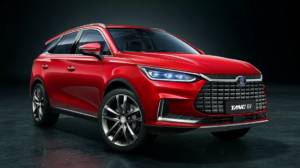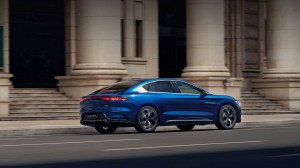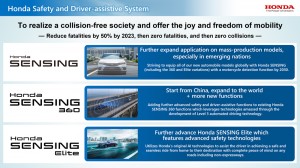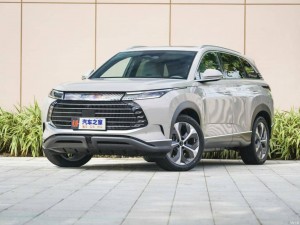

Follow us on social media:
Runtime: 8:58
0:00 Tesla Semi Rolls Out on the Red Carpet
0:34 GM Plays Long Game with AVs
1:13 Honda, Toyota Lose Most Customers to Tesla
2:41 BYD Moves Into Mexico
3:22 BYD Outsells VW in China
3:59 Canada Becoming EV Raw Material Powerhouse
4:36 BMW Invests in U.S. Copper
5:53 Honda Puts ADAS on Steroids
6:39 OEMs Need to Commonize EV Components
7:33 BYD Launches the Corvette 07
Visit our sponsors to thank them for their support of Autoline Daily: Bridgestone, Intrepid Control Systems, and Schaeffler.
This is Autoline Daily, the show dedicated to enthusiasts of the global automotive industry.
TESLA SEMI ROLLS OUT ON THE RED CARPET
After multiple delays, Tesla is finally unveiling its Semi truck today at its Gigafactory in Nevada. Last week, Elon Musk tweeted that they completed a 500-mile drive with a fully loaded truck weighing 81,000 pounds. There’s no word on official pricing yet but back in 2017, the company said it will cost $180,000. But we’ll learn more about the Semi later today.
GM PLAYS LONG GAME WITH AVs
Ford and Volkswagen threw in the towel. They’re pretty much giving up on autonomous vehicles for now. But General Motors is playing the long game. GM Cruise’s COO Gil West tells Reuters they’ll expand into a “large number of markets” with “thousands of vehicles” next year. Some of those AVs should be the Cruise Origin shuttle that will help lower costs. We’ve got to hand it to GM CEO Mary Barra for her long term approach. She says GM will continue investing $2 billion a year in Cruise because she expects it to generate $50 billion a year in revenue by 2030.
TOYOTA, HONDA LOSE MOST CUSTOMERS TO TESLA
Tesla is losing market share as more EVs hit the market. It’s basic math. All market share has to add up to 100%. And as more EVs enter the market, the pie gets sliced thinner. S&P Global Mobility reports that new EV models are eating into Tesla’s share. For the first nine months of the year it had 65% of the EV segment in the U.S. But that’s down from nearly 80% in 2020. Specifically, it’s losing share to EVs priced below $50,000, where it really doesn’t compete right now. But it still dominates the luxury segment with 86% market share. Tesla doesn’t need to worry about losing market share as long as its sales keep growing. And right now, S&P Global says Toyota and Honda are losing the most buyers to Tesla.
BYD MOVES INTO MEXICO
Earlier in the week, we reported that Chinese EV maker NIO plans to get into the U.S. and now another Chinese automaker says it will jump into the North American market. BYD will start selling EVs in Mexico next year, launching with its Tang SUV and Han sedan models. They’ll initially be sold through eight dealers, which will jump to 30 by 2024. By that time, BYD is aiming to sell up to 30,000 vehicles with a long-term goal to hit 10% market share. We think BYD is just dipping its toe in the Mexican market with the idea of moving north of the border sometime in the future. (PICTURED: BYD Tang – Top; BYD Han – Bottom)
BYD OUTSELLS VW IN CHINA
And speaking of BYD, it’s on a tear in China. According to data from China Merchants Bank International, the automaker was the number one brand in sales in November. It sold nearly 153,000 vehicles, up 83% compared to a year ago and it’s the first time it topped the sales charts. That was ahead of the VW brand, which sold more than 143,000 vehicles but if you include Audi, the Group outsold BYD. Even still, this has to be alarming to VW and even GM, which used to dominate sales in China.
CANADA BECOMING EV RAW MATERIAL POWERHOUSE
Canada is poised to become a major source of raw materials for electric cars, like copper, nickel, cobalt and lithium. It also wants to become a major processing center for those materials, especially in Quebec which runs mainly on hydroelectric power. For automakers in North America that would greatly slash their carbon footprint for manufacturing electric vehicles. And that’s a key reason why Volkswagen is looking for a site to make battery cells in Canada. Keep your ears open, you’re going to start hearing a lot more about EV production in the Great White North.
BMW INVESTS IN U.S. COPPER
Speaking of critical materials for EVs, BMW is securing the supplies of copper it needs and is doing it in a more sustainable way. The automaker is taking a stake in the U.S.-based company, Jetti Resources, which has come up with a way of extracting copper from previously unused ore. It uses what it calls a catalytic leaching technology to pull the copper out of material that used to sit in dumps and was considered waste. It says around 70% of the world’s copper resources are stored in this type of ore. And Jetti Resources method cuts CO2 emissions from the extraction process by 40% and water usage by 50%.
HONDA PUTS ADAS ON STEROIDS
Honda is rolling out the next-gen versions of its advanced driver assistance systems, called Honda Sensing 360. It’s adding hands-off highway driving, technology to detect the driver’s level of alertness and an emergency support system if the driver is unresponsive. The tech was launched in China earlier this year and will be available in other markets in the second half of the decade. By 2030 it will be standard on all Honda and Acura models in the U.S. After that it will launch a more advanced system, called Honda Sensing 360 Elite, that offers hands-off driving in traffic jams on surface streets, merging onto and exiting the highway and automatic parking in a home garage.
OEMs NEED TO COMMONIZE EV COMPONENTS
There are only 6 automatic transmissions for rear drive pickups and SUVs in the world. And it took 50 years for the industry to get that down to only 6. Even though those transmissions are made by different companies, they use a number of common components. And that gives the suppliers who make those components high economies of scale and low cost. Imagine if automakers would do the same thing with EVs. That’s another thing that was discussed at the SAE’s recent North American International Propulsion Conference. If automakers would use common components in motors, inverters, battery packs and gear reduction units they could get much higher economies of scale. Not all the components would have to be the same. And this could be another strategy for automakers to cut the costs of their electric cars.
BYD LAUNCHES THE CORVETTE 07
Have you heard about the newest Corvette? The Corvette 07 from BYD in China? It’s an ICE-powered 4-door crossover that’s priced between $30,000 and $40,000. So how the heck can BYD get away with calling it a Corvette? That’s because its Chinese name can be interpreted as either frigate or corvette, which is a type of warship designed to escort bigger ships and convoys. Since it uses a Chinese name it probably doesn’t pose any trademark infringement on the classic American sports car. But it sure sounded weird to us to hear about the BYD Corvette.
How is Jeep going to respond to attacks from Ford with the Bronco and from VW with the Scout? That’s one of the things we’re going to ask Jim Morrison this afternoon on Autoline After Hours. He’s the head of Jeep in North America. Roman Mica who runs the TFL channel on YouTube will also be on the show, so join John and Gary when they go live at 3 pm this afternoon right here on Autoline.
But that’s a wrap for today’s show. Thanks for joining us.
Thanks to our partner for embedding Autoline Daily on its website: WardsAuto.com
Seamus and Sean McElroy cover the latest news in the automotive industry for Autoline Daily.









